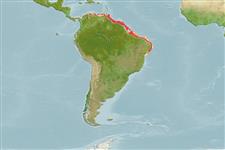Common names from other countries
Environment: milieu / climate zone / depth range / distribution range
Écologie
marin récifal; profondeur 0 - 70 m (Ref. 13608). Tropical; 12°N - 13°S, 82°W - 34°W
Western Atlantic: Panama to Brazil.
Taille / Poids / Âge
Maturity: Lm ? range ? - ? cm
Max length : 40.0 cm TL mâle / non sexé; (Ref. 5217); common length : 25.0 cm TL mâle / non sexé; (Ref. 5217); poids max. publié: 1.2 kg (Ref. 5217)
Épines dorsales (Total): 3; Rayons mous dorsaux (Total): 29; Épines anales 0; Rayons mous anaux: 23 - 25; Vertèbres: 36 - 38. Head depressed, trunk compressed; molariform teeth on both jaws; no venomous gland on any spine; body brownish dorsally with black diffuse mottlings, pale ventrally; lateral line pores distinct with white spots; fin membranes black distally (Ref. 13608).
Inhabits littoral (subtidal) waters; usually found on sandy or rock bottom; large fish may be found in waters less than 1 m of depth hiding in crevices or caves (Ref. 3273). Feeds mostly on molluscs and crustaceans. Reported to be moderately abundant and regularly consumed by fishermen (Ref. 50841). Eggs are deposited on the shells of mollusks and on stones. One of the very few marine fishes that guards fry and juveniles. It is caught in traps and special types of hooks (garrapinos) (Ref. 50841). Marketed fresh.
Life cycle and mating behavior
Maturité | Reproduction | Frai | Œufs | Fécondité | Larves
One of the few marine fishes that provide posthatching care. Males actively guard free-swimming juveniles in burrows (Ref. 13442, 101618). Males may mate more than once a year (Ref. 101618).
Collette, B.B., 1978. Batrachoididae. In W. Fischer (ed.) FAO species identification sheets for fishery purposes. West Atlantic (Fishing Area 31), Volume 1. FAO, Rome. (Ref. 3273)
Statut dans la liste rouge de l'IUCN (Ref. 130435)
CITES (Ref. 128078)
Not Evaluated
Menace pour l'homme
Harmless
Utilisations par l'homme
Pêcheries: intérêt commercial mineur
Plus d'informations
RéférencesAquacultureProfil d'aquacultureSouchesGénétiqueElectrophoresesHéritabilitéPathologiesTraitementMass conversion
CollaborateursImagesStamps, Coins Misc.SonsCiguateraVitesseType de nageSurface branchialeOtolithesCerveauxVision
Outils
Articles particuliers
Télécharger en XML
Sources Internet
Estimates based on models
Preferred temperature (Ref.
115969): 26.9 - 28, mean 27.5 (based on 130 cells).
Phylogenetic diversity index (Ref.
82804): PD
50 = 0.7500 [Uniqueness, from 0.5 = low to 2.0 = high].
Bayesian length-weight: a=0.00389 (0.00180 - 0.00842), b=3.12 (2.94 - 3.30), in cm Total Length, based on all LWR estimates for this body shape (Ref.
93245).
Niveau trophique (Ref.
69278): 3.8 ±0.0 se; based on diet studies.
Résilience (Ref.
120179): Faible, temps minimum de doublement de population : 4,5 à 14 années (Preliminary K or Fecundity.).
Fishing Vulnerability (Ref.
59153): Low to moderate vulnerability (30 of 100).
